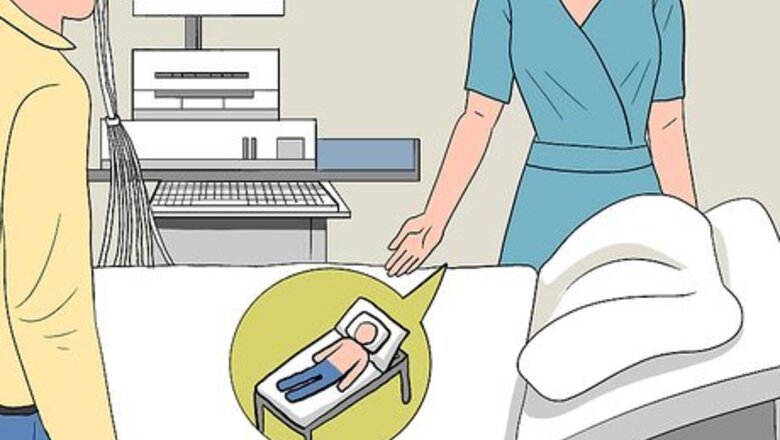
views
Preparing the Patient
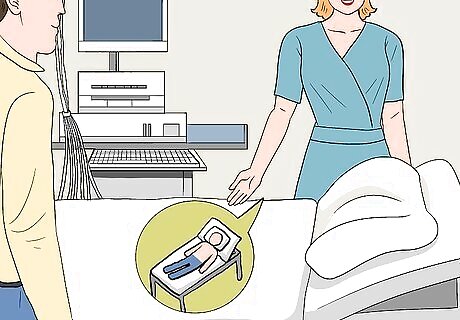
Ask the patient to recline on their back. ECG tests are always administered with the patient lying flat on their back. Not only does this position make it much easier to find the correct places to situate the ECG leads, but it also keeps the patient’s heart beating at its resting rate. If you’re in a doctor’s office, just have the patient lay back on an examination table. If you’re giving an ECG test in a patient’s home, ask them to recline on their bed or couch.

Gain verbal consent to the procedure from the patient. Explain that you’re about to place 10 leads on the patient’s body to electrically monitor their heartbeat. Clarify that the test will not hurt, but that the leads will need to remain in place on the skin for 3–5 minutes. Ask the patient to take a few deep breaths and completely relax. If the patient is female, they may feel more comfortable with a female doctor or nurse placing the ECG leads on their chest.
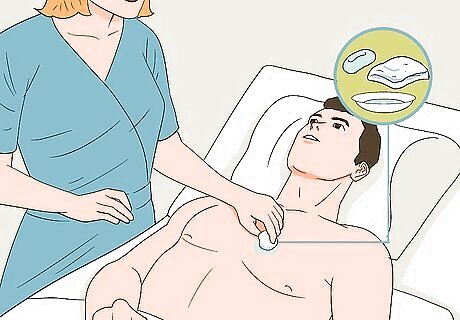
Clean the patient’s chest before you place the leads. If the patient’s skin is dirty or oily, clean it with soap and water and dry with a towel before applying the ECG leads. Dirt and oil can interfere with the electrical signals from the leads. They’ll also have a much harder time sticking onto a dirty chest. If a patient has chest hair where the leads should be placed, you’ll need to shave off the hair. It’s also a good idea to either wash your own hands or put on a pair of latex gloves before putting on the ECG leads. If you don’t have soap and water available, you can also use an alcohol cleaning pad to remove dirt and oil.
Positioning the Chest Leads
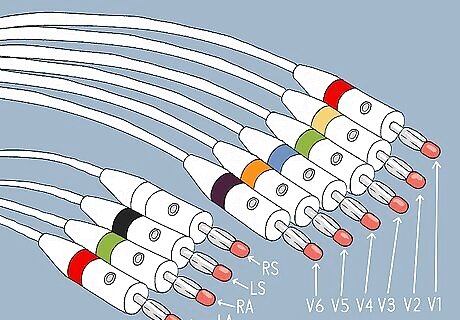
Unpack the ECG leads and read the color-coding system. The leads used in an ECG exam are color coded. There will be a chart on the ECG packaging that lets you know which color corresponds with which lead. You have to put some of them on the chest. The 6 chest leads are medically referred to as the “V” leads. They’re numbered V1 through V6, with V1 being the first lead applied and V6 being the last. The 4 leads that you’ll place on the patient’s arms and legs should also be color coded. They may be packaged separately from the torso leads to avoid confusion.
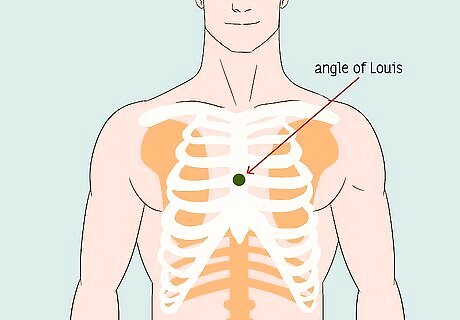
Find the “angle of Louis” to determine chest electrode placement. Set your fingers at the base of the patient’s throat and slide them slowly down until you feel the top of the sternum. Slide your fingers down across the sternum another 5–6 inches (13–15 cm) until you reach the sternum’s widest part. This is the angle of Louis. You’ll know you’ve arrived at the angle of Louis when until you feel a bony lump where the 2nd rib connects to the patient’s sternum. Knowing the location of the angle of Louis will help you position the ECG electrodes. Having the patient reclining makes it much easier to find the angle of Louis. If it helps, practice finding the angle of Louis on yourself a few times before you find it on a patient.

Place V1 between the patient’s ribs on the right side of their sternum. Move your fingers to the right of the angle of Louis. As your fingers slide right, you’ll feel a gap between the patient’s ribs. Slide your fingers down across 1 more rib until you come to the next gap between ribs. Place the first lead here. To set the lead, press it firmly into place. The leads are lightly adhesive and will stay in the location you put them. V1 should be located between the patient’s 4th and 5th ribs, counting down from the top.
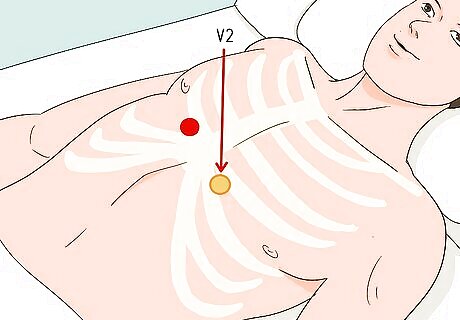
Set V2 across the patient’s sternum from V1. Place your hand back onto the patient’s angle of Louis and this time slide your hand to the left. Find the gap between the patient’s ribs and, as with V1, slide your fingers down across 1 more rib. Set electrode V2 in that gap between ribs, as close to the patient’s sternum as possible. V2 should essentially mirror the placement of V1, but on the left side of the chest.

Position V4 beneath the midpoint of the patient’s’ left clavicle. From where you just placed electrode V2, slide your fingers down 1 more rib until you can feel the space between 2 ribs again. Then, slide your fingers to the right (this will be going farther left from the patient’s point of view). Place V4 directly under the midpoint of the patient’s left clavicle, in the space between 2 ribs. The clavicle is the collarbone. It often slightly protrudes just below the patient’s neck.
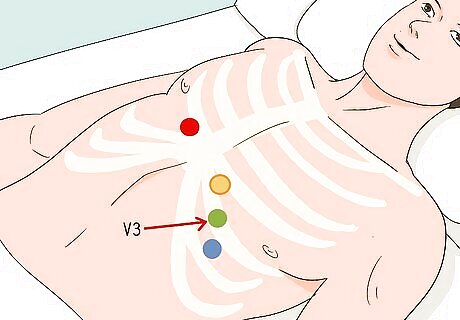
Set V3 directly between nodes V2 and V4. Don’t worry about lining V3 up with a gap between ribs. In fact, on most patient’s bodies, it will sit directly over a rib. Just eyeball half of the distance between electrodes V2 and V4, and stick V3 in that position. If you’re working with a female patient, leads V3 through V6 will be positioned beneath—not on top of—the patient’s left breast.
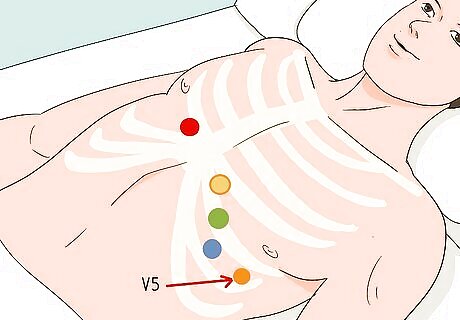
Situate V5 at the same height as V4 below the patient’s axilla. Slide your fingers right along the gap between ribs. Follow the gap between the patient’s ribs where you placed V4. Move your fingers to the right (left, from the patient’s point of view) and follow the gap. Move your fingers until they’re directly beneath the beginning of the patient’s underarm. Press V5 into place here. In medical terminology, the underarm area is known as the axilla.
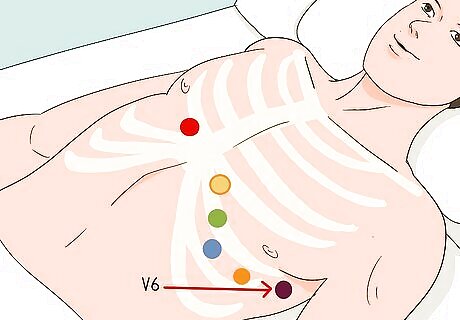
Set V6 directly under the center of the patient’s left underarm. Continue moving your fingers to the right (the patient’s left) along the line of the gap between 2 ribs that you’ve been following. Keep moving until your fingers are directly beneath the center of the patient’s underarm. Place V6 there, still in the gap between the patient’s ribs. It’s a good idea to always position the chest leads before positioning the extremity electrodes. The chest electrodes are more important and they need to be much more precisely located.
Setting the Extremity Leads

Stick 1 lead to the patient’s right shoulder below the clavicle. Fix a lead on the patient’s arm on the shoulder about 2 inches (5.1 cm) below the patient’s clavicle. Press the lead firmly onto the patient’s skin to fix its position. If you can’t position the lead here for some reason (e.g., the patient has a skin lesion), place the lead higher up on the patient’s shoulder. You can also place it farther out away from their neck if necessary. The lead for the right shoulder is usually white.
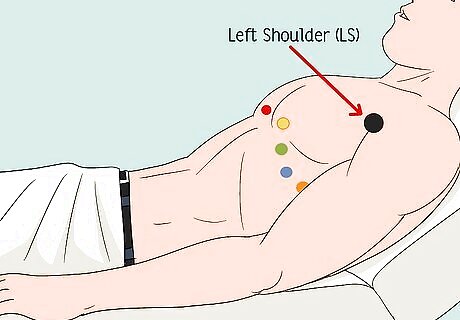
Press 1 lead onto the left shoulder below the clavicle. As on the right arm, this lead should fall about 2 inches (5.1 cm) below the clavicle. Place the lead at roughly the same location as you placed the lead on their right side to ensure that both arm leads give accurate readings. Press down firmly on the lead to fix it in place. If the patient has a defibrillator on their chest or has a pacemaker, do not place the ECG lead on the electrical device. Instead, move the lead 1 inch (2.5 cm) in any direction so it’s directly on top of the skin. The lead that goes on the left shoulder is usually color-coded black.
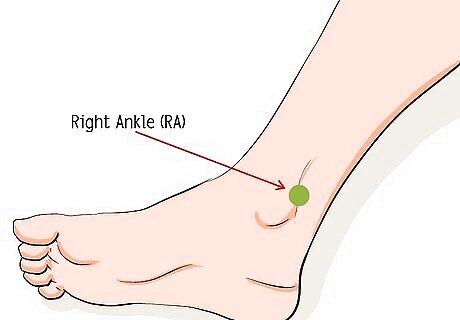
Fix a lead onto a fleshy spot on the patient’s right ankle. You have quite a bit of leeway when sticking the leads onto a patient’s ankle, especially when compared with sticking them onto the patient’s chest. Aim to place the lead just below the patient’s ankle bone where there’s a fleshy patch. Avoid placing the lead directly over a bony part of the ankle. If the patient is wearing socks and shoes, ask the patient to remove them so you can put on the lead. The right ankle lead typically has a green color.

Press a lead onto the patient’s left ankle below the ankle bone. Just like with the right ankle, position the lead on the ankle over a fleshy patch. If the patient has a very bony ankle, you could position the lead at the top of the patient’s instep. Make sure to position the lead on the left ankle in roughly the same position as on the right ankle. It’s more important that the leads be symmetrically positioned than they be on any exact location on the ankles. The lead that goes on the left ankle tends to be red.



















Comments
0 comment